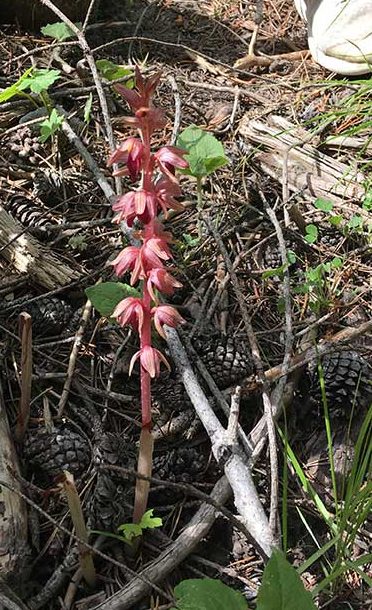Corallorhiza maculata / spotted coralroot
- short, brown/red leafless flowering stalk, often in clumps
- intricate all brown/red-ish flowers except for a white lower lip, with reddish spots
- in conifer or aspen forest understory
Also known as: summer coralroot, western coralroot, speckled coral root, large coral root, many-flowers coral root
Corallorhiza maculata is a terrestrial orchid, and despite the fact that we usually think of orchids as exotic, its range covers a good bit of the US and Canada. It is, however, seldom seen and rather hard to find even if you are looking for it. Spotted coralroot occurs occasionally as a single above ground flowering scape (the stalk of an orchid inflorescence) but often as numerous scapes from a clone. It has a rhizome, sometimes quite spreading. That, and the lower stem, are often knotted into branched coral-like shapes, hence the name, both in Latin and English.
The C. maculata stem is usually red or brown in color, but occasionally comes in a light yellow or cream color in albino plants. There are no leaves and no photosynthetic green tissues. The stems bear dark red scales and many (up to 40-ish) intricate orchid flowers in a raceme. The flowers are small and come out from all sides of the stem. The sepals, like the stem, are dark red or brown tinged with purple; they are long and pointed. The side petals are reddish. So basically the whole plant is brown-ish, red-ish… except for the lip petal (labellum) of the flower. It is bright, clean white with deep red spots, and is usually scalloped along its edges.
The coralroot orchid is self-pollinating after the flower has opened, but insect pollination can occur before and after self-fertilization. The insects, as is true for many orchids, have to do some contortions to get to the pollen. Unlike non-orchids on this site, orchid pollen comes in pollen sacs, pollinia, which are located on the underside of a conspicuous, central style. They basically end up stuck to the pollinator’s back.
All this means that if you do find the plant, you should be happy. Perhaps give your dog an extra treat. Or take your kids out for a huckleberry shake.
But coralroot orchids are weirder than what I’ve described so far. First, they are myco-heterotroph. They lack chlorophyll, which is why they are brown or red or yellow and not green, even if you grind them up in acetone or alcohol. But they still need energy and nutrients to grow. And to be truly odd about that, they get those by parasitizing the mycelium – the thread-like “body” cells – of fungi. But fungi also can’t do photosynthesis, and they obtain their carbon, their energy source, from the roots of other plants. In the Valley, these are trees, conifers or aspens, and the fungi are especially prevalent in moist forests with soils rich in humus.
Because coralroot has no chlorophyll, it really doesn’t need to come up above ground. Light does nothing for it, as it were. Indeed, sometimes, it remains in the soil for years, so if you find a clump this year, it may be gone next year, but back 10 years from now. It isn’t dead; it continues to grow and do what we call “live” all the while. So it is really a subterranean plant that once in a while produces above-ground flowers.
This whole orchid/fungus interaction is quite specific. C. maculata utilizes fungi in the family Russulaceae. In all, there are at least 18 different fungal entities that associate with this one species of orchid. These fungi are basidiomycetes, i.e. they produce mushrooms at some point, some edible. But at this stage, they are “ectomycorrhizae” – myco (fungus) associated with rhizae (roots), performing a kind of symbiosis where the fungi form sheaths over the roots with long stringy cells (hyphae) extending into the soil to pick up nutrients and water. In this case, the association is both with the roots of the orchid and with those of nearby trees. The fungi, by the way, don’t get anything from the orchids… the orchids are “cheaters” (an actual ecological term).
Although there are other ectomycorrhizal fungi in the soil, none but the Russelaceae colonize the orchids, and the ones that do (Russula spp.) are highly specific for their own particular bunch of the orchid. In fact, just within C. maculata, plants with slightly different genotypes (i.e. complements of genes with very small differences in them), growing near each other, all maintained association with distinct fungal lines.
Despite some reports, including in Earle and Lundin, that describe C. maculatum as a saprophyte (i.e. living off dead things), there is significant doubt that any plant is actually saprophytic. Rather, as in this case, they are parasitic, obtaining all of their energy from a live host.
One last thing … Corallorhiza maculata is also the topic of the poem On Going Unnoticed by Robert Frost. Enjoy.
| Color | |
|---|---|
| Family | |
| Blossom size | |
| Inflorescence size | |
| Inflorescence type | |
| When? | |
| Where? |



